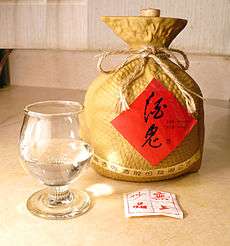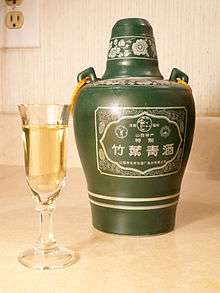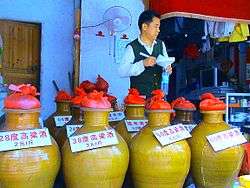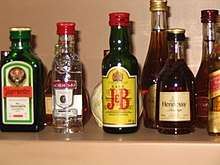Baijiu
 A glass and bottle of Jiugui brand baijiu | |
| Type | Distilled beverage |
|---|---|
| Country of origin | China |
| Alcohol by volume | 28-65% |
| Proof (US) | 56-130 |
| Colour | clear |
| Variants | light aroma, strong aroma, sauce aroma, rice aroma, phoenix aroma, mixed aroma, chi aroma, sesame aroma, medicine aroma, extra-strong aroma, special aroma, laobaigan, small qu baijiu |
| Related products | shōchū, soju, huangjiu |
| Baijiu | |||||||||||||||||||||||
|
"Baijiu" in Chinese characters | |||||||||||||||||||||||
| Chinese | 白酒 | ||||||||||||||||||||||
|---|---|---|---|---|---|---|---|---|---|---|---|---|---|---|---|---|---|---|---|---|---|---|---|
| Literal meaning | "white (clear) alcohol" | ||||||||||||||||||||||
| |||||||||||||||||||||||
| Alternative Chinese name | |||||||||||||||||||||||
| Traditional Chinese | 燒酒 | ||||||||||||||||||||||
| Simplified Chinese | 烧酒 | ||||||||||||||||||||||
| |||||||||||||||||||||||
Baijiu (Chinese: 白酒; pinyin: báijiǔ), also known as shaojiu, is a category of at least a dozen Chinese liquors made from grain. Báijiǔ literally means "white (clear) alcohol" or liquor.
Báijiǔ is a clear liquid usually distilled from fermented sorghum, although other grains may be used; some southeastern Chinese styles may employ rice or glutinous rice, while other Chinese varieties may use wheat, barley, millet, or even Job's tears (yìyǐ) in their mash bills. The jiuqu starter culture used in the production of baijiu is usually made from pulverized wheat grain or steamed rice.[1][2][3][4][5][6]
Because of its clarity, baijiu can appear similar to several other East Asian liquors, but it often has a significantly higher alcohol content than, for example, Japanese shōchū (25%) or Korean soju (20–45%). Despite being a white spirit, it more closely resembles a dark spirit like whisk(e)y in terms of complexity and mouthfeel.
It is the most widely consumed spirit (alcohol) in the world, with 5 billion litres sold in 2016.[7]
History
Liquor has been distilled in China since at least the Yuan Dynasty,[8][9] though baijiu began to resemble its current form around the Ming Dynasty. Baijiu is characterized by solid-state fermentation and distillation using a grain culture called qu, which allows for simultaneous saccharification and fermentation. This is a typical feature of liquors produced in the Far East. Chinese baijiu is always distilled from grain, produced in batches and blended.[8][9]
Serving
The Chinese traditionally serve baijiu neat at room temperature.[10] Baijiu is served in small cups or glasses, though drinkware varies by region. It is traditional to drink baijiu with food rather than on its own, though it is often infused with fruit or medicinal herbs and spices.[2] In 2007, a report in Time magazine mentioned integrating baijiu into cocktails,[11] and in the years since several bars around the world have added baijiu to their cocktail programs.[12]
Pricing
Low grades of baijiu can be inexpensive; a bottle of roughly 250 ml (8 oz) may be purchased for the same price as a can of beer.[13] However, higher grades, which are often aged for many years, can command much higher prices. The highest grade of Wuliangye retails for CN¥26,800 (US$3,375).[14] Some popular baijiu brands include Kweichow Moutai, Red Star Erguotou, Luzhou Laojiao, and Wuliangye.
Classification
Unlike huangjiu, which has a wide variety of classification methods, the Chinese government classifies baijiu linguistically by its aroma, though styles are distinguished by production methods, ingredients and other regional variations. Baijiu has a distinctive smell and taste that is highly valued in Chinese culinary culture, and connoisseurs focus especially on its fragrance. This classification system began in 1952 and was updated in August 1979 at the third nationwide baijiu competition held in the city of Dalian. Even so, during the competition, experts rated various baijiu based on their taste rather than aroma.[15]
The four major categories of baijiu, accounting for the overwhelming majority of the market, are strong aroma, light aroma, sauce aroma, and rice aroma. The following aroma categories are direct translations of the current Chinese classifications.
- Sauce aroma (醬香, jiàngxiāng): A highly fragrant distilled sorghum liquor of bold character, named for its similarity in flavor to Chinese fermented bean pastes and soy sauces. It is made from sorghum repeatedly fermented in stone brick pits. To the Western palate, sauce fragrance baijiu can be quite challenging. It has large amounts of ester compounds, which impart a layered umami flavor. To the initiated, it is quite delicious and is considered the perfect complement for fine preserved and pickled foods (醬菜, jìangcài). This class was formerly known as "Mao-aroma" (茅香), after the best known liquor of this class, Maotai.
- Strong aroma (濃香, nóngxiāng): A class of distilled liquor that is sweet tasting, unctuous in texture, and mellow, with a gentle lasting fragrance contributed by the high levels of esters, primarily ethyl hexanoate,[16] which give the spirit a strong taste of pineapple, banana and anise. Most liquors of this class are distilled from sorghum, sometimes in combination with other grains, continuously fermented in mud pits. This style is formerly known as "Lu aroma" (瀘香, lúxiāng), after the supposed inventor of the style, the Luzhou Laojiao Distillery in Luzhou. Other notable examples of this type of liquor is Wuliangye from Yibin, Jiannanchun from Mianzhu, and Yanghe from Suqian.
- Light aroma (清香, qīngxiāng): Delicate, dry, and light, with a delectable mellow and clean mouthfeel. The flavours of this distilled liquor is contributed primarily by ethyl acetate and ethyl lactate,[17] and give the spirit a taste of dried fruit with floral notes. It is made from sorghum fermented in a stone vessel with qu made from wheat bran or a combination of barley and peas. The two primary styles of An example of this kind of liquor are Fenjiu (汾酒, fénjiǔ) from Shanxi and erguotou (二锅头, èrguōtóu) from Beijing, the latter of which is known as Kaoliang (高粱, gāoliáng, lit. "sorghum") in Taiwan. Formerly this style was called Fen-aroma (汾香, fēnxiāng) after the Xinghuacun Fenjiu Distillery.
- Rice aroma (米香, mǐxiāng): The character of this class of liquor is exemplified by baijiu distilled from rice, such as Sanhuajiu (三花酒) from Guilin. This type of liquor has long history and is made using rice-based Rhizopus spp.-type qu starters (小曲, xiǎoqū, lit. "little qu").[8] It has a clean mouth-feel and is slightly aromatic aroma, dominated by ethyl lactate with lesser flavour contributions by ethyl acetate.
- Phoenix aroma (凤香, fèngxiāng): A class of distilled liquor fermented in mud pits and aged in rattan containers. Liquors of this class have a fruity taste similar to strong-aroma baijiu, but also an earthier quality and an expanding finish. An example of this type of liquor is Xifengjiu from Fengxiang County in Shaanxi.
- Mixed aroma (兼香, jiānxiāng): A class of distilled liquors that is a blend of two or more varieties of baijiu. As such, liquors of this class vary widely in their aroma, mouth-feel, and dryness.
- Sesame aroma (芝麻香, zhīmaxiāng): A class of liquor distilled from sorghum, millet or barley in stone pits with mud floors. Invented by the Jingzhi Distillery in the 1950s, sesame aroma employs similar production techniques to sauce-aroma baijiu, and has a charred, nutty flavor.
- "Chi" aroma (豉香, chǐxiāng), also fat aroma (脂香, zhīxiāng): Named after douchi, the popular Chinese condiment made from fermented bean, this is a savory rice-based baijiu from Guangdong notable for the addition of pork fat during the aging process.
- Medicine aroma (药香, yàoxiāng): A pungent liquor that originates at the Dongjiu (董酒) Distillery in Guizhou. Medicine aroma is distilled from the combination of two separate pit-fermented sorghum mashes, one fermented with wheat qu in a large pit and one fermented with medicinal rice qu in a small pit.
- Extra-strong aroma (馥郁香, fùyùxiāng): This category refers to the liquor produced by the Jiugui (酒鬼) Distillery in Hunan. Distilled from sorghum, rice, glutinous rice, wheat and corn that has been fermented with big qu and medicinal small qu.
- Special aroma (特香, tèxiāng): A rice-based baijiu fermented in brick pits with big qu, it originates from the Sitir (四特) Distillery in Jiangxi.
- "Laobaigan" aroma (老白干香, lǎobáigānxiāng): Similar to light-aroma baijiu, but fermented with wheat-based big qu and bottled at extremely high proof. Most often associated with the Hengshui Ruitian (衡水瑞天) Distillery in Hebei.
- Small-qu light aroma (小曲清香, xiǎoqū qīngxiāng): A style of baijiu distilled from sorghum that has been fermented with rice-based small qu.
Types
Winemaking in China predates baijiu by thousands of years.[18] When liquor arrived there were already a number of regional variations in alcohol production technique across the country, and some of these have been incorporated into baijiu making.[8] The practice of infusing alcohol with herbs, spices, fruits and other ingredients has its roots in traditional Chinese medicine, but is also done purely for flavor. The practice of infusing spirits is a common practice throughout China.[9]

Sub-categories and regional variations
- Fenjiu (汾酒, fénjiǔ): Grain alcohol in Fenyang, Shanxi dates back to the Northern and Southern Dynasties (AD 550). Most commonly associated with the Xinghuacun Distillery, Fenjiu is a light-aroma sorghum baijiu fermented with qu made from barley and peas.
- Erguotou (二锅头, èrguōtóu, lit. "head of the second pot") is a variant of light-aroma baijiu. It is often inexpensive and thus particularly popular among blue-collar workers across northern and northeastern China. It is probably the most commonly-drunk baijiu in Beijing and is frequently associated with that city. Red Star (红星, Hóngxīng) is a popular brand.
- Kaoliang wine (高粱酒, gāoliángjiǔ): Kaoliang is an old Romanized spelling for the Chinese word for sorghum, gaoliang (高粱). The liquor originates from Dazhigu (大直沽, located east of Tianjin), first appearing in the Ming Dynasty. Nowadays, Taiwan is the leading producer of Kaoliang wine.
- Daqujiu (大麴酒, Dàqūjiǔ): Originally from Sichuan. This liquor is made with sorghum and wheat qu and is fermented for two to three months in mud pits. Also known as strong-aroma baijiu.
- Sanhuajiu (三花酒, Sānhuājiǔ, lit. "Three Flowers Liquor"):photo a rice baijiu made in Guilin that borrows techniques from local rice wine tradition. It is famous for the fragrant herbal addition, and the use of spring water from Mount Xiang in the region.
- Shuangzhengjiu (雙蒸酒, shuāngzhēngjiǔ, lit. "double-distilled liquor") and Sanzhengjiu (三蒸酒, sānzhēngjiǔ, lit. "triple-distilled liquor", formerly known as "samshu"): Two varieties of rice-aroma baijiu from the area of Jiujiang in Jiangxi and in Guangzhou Province, made by distilling twice and three times respectively. Alcohol content by volume: 32% and 38–39% respectively.[19] "Samshu" was the name by which most foreign travelers knew baijiu during the Qing Dynasty.
Brands
- Yanghe (洋河, yánghé): Yanghe Daqu began to flourish in the Ming and Qing dynasties, and was presented as the tribute to Qing royals. After the founding of the country, the liquor was able to be enjoyed by citizens across the nation. Carrying on millennia of traditional craftsmanship, Yanghe Daqu uses only the highest quality sorghum as a base and only the best wheat, barley and peas as high-temperature fermenting agents.
- Luzhou Laojiao (泸州老窖): Luzhou Laojiao is one of the most popular liquors in China, with the history extending over 400 years. It is famed for the quality of its distillation along with its unique aroma and mouth-feel, the latter of which is due to the unique clay used within the brewing environment, which infuses the spirit with the taste it is so renowned for.
- Liulingzui jiu(刘伶醉): Liulingzui originates from Wei and Jin Dynasties. The wine is made by strictly following the traditional process of Five Utensils. Its special quality is favored by the consumers. Liulingzui has achieved a lot of prizes and awards, such as: Special Gold Award of the Paris Exposition, the first batch of China Food Cultural Heritage, the first batch of China’s Time-honored Brand, National Geographical Indication Products and the National Key Cultural Relics Protection Units.
- Wuliangye (五粮液, Wǔliángyè) is a strong, aged distilled liquor produced in the city of Yibin in southern Sichuan.[20] Its factory includes a Liquor History Museum on its grounds.[21] Wuliangye uses five grains (sorghum, rice, glutinous rice, corn, wheat) as its raw material, hence the name "Five-Grain Drink". The water which is used to brew Wuliangye is from the Min River.
- Jiugui (酒鬼, jiǔguǐ, lit. "drunk ghost" or "drunkard") is a clear distilled liquor made from spring water, sorghum, glutinous rice, and wheat. It is produced by the Hunan Jiugui Liquor Co., Ltd. in the town of Zhenwu near Jishou in the Xiangxi Tujia and Miao Autonomous Prefecture in the western part of Hunan. It ranges from 38% to 54% alcohol by volume.[22]
- Gujinggongjiu(古井贡酒, gǔjǐinggongjiu, lit. "Ancient Well Tribute Liquor") is a traditional Chinese liquor made from water from a well in Bozhou, Anhui Province. The history began in Southern and Northern Dynasty (AD196), people lived in Bozhou found that there was an old well that produced very clean and sweet, so they started using the water to produce the tea and grain wine. Then, it was famous in ancient China so people gave it to Emperor Xie Liu of Han as a tribute. It is produced by the Bozhou Gujinggongjiu Liquor Co., Ltd. at Anhui Province. It ranges from 38% to 50% alcohol by volume.
- Kweichow Moutai (贵州茅台, Guìzhōu Máotái): This liquor has a production history of over 200 years, and originally coming from the town of Maotai in Guizhou. It is made from wheat and sorghum with a unique distilling process that involves seven iterations of the brewing cycle. This liquor became known to the world after winning a gold medal at the 1915 Panama-Pacific Exposition in San Francisco, California. Mao Zedong served Moutai at state dinners during Richard Nixon's state visit to China, and Henry Kissinger once remarked to Deng Xiaoping that, "if we drink enough Maotai, we can solve anything".[23] Alcohol content by volume: 53%.
- Guotai (国台酒, Guotai Spirits) is distilled seven times to produce a crisp, clear flavor, that is perfect for any occasion. The authentic spirit is made from wheat and a red sorghum cultivated in China’s agricultural heartland. Guotai uses an ancient Chinese distillation process, resulting in an exceptional hand-crafted spirit that honors tradition.
- Yuk Bing Siu Zau (玉冰燒酒, Yùbīng Shāojiǔ) or roulaoshao (肉醪燒, ròuláoshāo): a Cantonese rice liquor with over 100 years of history, made with steamed rice. After distillation, pork fat is stored with the liquor but removed before bottling. Its name probably derives from the brewing process: in Cantonese, "jade" (yuk) is a homophone of "meat", and bing means "ice", which describes the appearance of the pork fat floating in the liquor. Cantonese rice wine breweries prospered in the Northern Song Dynasty, when the Foshan area was exempted from alcohol tax. Alcohol content by volume: 30%.
- Jian Lan Chun (剑兰春, jiàn lán chūn): Jian Lan Chun is a famous traditional Chinese wine, which is produced in Mianzhu city, Sichuan province. Mianzhu in the Tang dynasty belongs to Jiannan zone, so-called "Jian Lan Chun". Liquor-making water is from Mianzhu northwest of the rare plateau water. The underground mineral water here is not affected by any foreign bacteria and surface water, forming the natural weak alkaline mineral water with excellent quality. Thus, the taste of Jian Lan Chun wine is tasted unusually pure and refreshing.
Popular infusions
- Mei Kuei Lu Chiew (玫瑰露酒, méiguīlujiǔ, lit. "rose essence liquor"): A variety of baijiu distilled with a special species of rose and crystal sugar. Alcohol content by volume: 54–55%.[24]
- Osmanthus wine (桂花酒) is a distilled liquor flavored with sweet osmanthus flowers. Its alcohol content is 17–18%.[25]
- Wu Chia Pi Chiew (五加皮酒, Wǔjiāpíjiǔ): a variety of baijiu with a unique selection of Chinese herbal medicine (including Angelica sinensis) added to the brew. Alcohol content by volume: 54–55%.[26]
- Chu Yeh Ching (竹葉青酒, zhúyèqīnqjiǔ, lit. "bamboo-leaf green liquor"): this sweet liquor, produced in Shanxi, is made from Fenjiu brewed with a dozen or more selected Chinese herbal medicines. One of the ingredients is bamboo leaves, which gives the liquor a yellowish-green color and its name. Its alcohol content ranges between 38 and 46% by volume.[27]
- To Mei Chiew (荼薇酒, túwéijiǔ) is a Cantonese liquor produced in Xiaolan Town near Zhongshan in Guangdong. It is made from rice baijiu, with added to mei flowers and crystal sugar syrup. Aged for more than one year. 30% alcohol by volume.[28]
- Pi Lu Chiew (碧綠酒, bìlǜjiǔ, lit. "jade green liquor"):[29] From Wuhan, this liquor is infused with Chinese medicinal herbs and sugar.[30]
- Imperial Lotus White Chiew (御蓮白酒, Yàlián báijiǔ): This is a variety of baijiu infused with twenty medicinal herbs. It was first produced for the Chinese royal family in 1790.[31]
- Chajiu (茶酒, chájiǔ, lit. "tea liquor") is a product of fairly recent origin. It consists of baijiu flavored with tea leaves and hawthorn berries. It is usually a light reddish-brown in color (similar to oolong tea) and varieties made with oolong, green, and black tea are available. Chajiu is produced by several manufacturers, primarily in the Sichuan province. Although the strength differs according to the brand and variety, chajiu ranges between 8% and 28% alcohol by volume.
See also
References
- ↑ Zheng, Xiao‐Wei, et al. "Daqu—A traditional Chinese liquor fermentation starter." Journal of the Institute of Brewing 117.1 (2011): 82-90.
- 1 2 Rong and Fa, Grandiose Survey of Chinese Alcoholic Drinks and Beverages, 2013, "Archived copy". Archived from the original on 2014-07-29. Retrieved 2015-05-29.
- ↑ Xiaoqing Mu et al Solid-State Fermented Alcoholic Beverages, in Chen, Jian, and Yang Zhu, eds. Solid State Fermentation for Foods and Beverages. CRC Press, 2013.
- ↑ Wang, H‐Y., et al. "Characterization and comparison of microbial community of different typical Chinese liquor Daqus by PCR–DGGE." Letters in Applied Microbiology 53.2 (2011): 134-140.
- ↑ Zheng, Xiao-Wei, et al. "Complex microbiota of a Chinese “ Fen” liquor fermentation starter ( Fen- Daqu), revealed by culture-dependent and culture-independent methods." Food microbiology 31.2 (2012): 293-300.
- ↑ Xiong, X., et al. "PCR-DGGE Analysis of the Microbial Communities in Three Different Chinese" Baiyunbian" Liquor Fermentation Starters." Journal of microbiology and biotechnology (2014).
- ↑ "Can China's national drink reignite interest in a new generation?". ABC News. 27 May 2017.
- 1 2 3 4 Huang, H. T. "Science and civilisation in China. Volume 6. Biology and biological technology. Part V: fermentations and food science." (2000).
- 1 2 3 Huang et al Chinese Wines: Jiu, in Hui, Yiu H., ed. Handbook of food science, technology, and engineering. Vol. 149. CRC press, 2006.
- ↑ Slaughter, Sam (May 17, 2016). "The Manual Guide to Baijiu".
- ↑ "Global Adviser". Time. 2007-07-16. Retrieved 2010-04-26.
- ↑ Risen, Clay (December 29, 2015). "Baijiu, the National Drink of China, Heads West". The New York Times.
- ↑ Hawkins, Amy (September 22, 2017). "Baijiu on a Budget". Time Out Beijing.
- ↑ "Wuliangye Distillery". Cbw.com. Archived from the original on 16 June 2011. Retrieved 2011-06-21.
- ↑ 余, 乾伟 (2010). 传统白酒酿造技术. 中国轻工业出版社.
- ↑ Yao, Yi, Shen, Tao, Liu, Lin, and Xu. (April 10, 2015). "Chemical Analysis of the Chinese Liquor Luzhoulaojiao by Comprehensive Two-Dimensional Gas Chromatography/Time-of-Flight Mass Spectrometry". Scientific Reports.
- ↑ Xiao; et al. "Effect of the environment microbiota on the flavour of light-flavour Baijiu during spontaneous fermentation". Scientific Reports.
- ↑ McGovern, Patrick (2009). Uncorking the Past: The Quest for Wine, Beer, and Other Alcoholic Beverages. University of California Press.
- ↑ Archived February 23, 2005, at the Wayback Machine.
- ↑ "Wuliangye Distillery". Cbw.com. Archived from the original on 16 June 2011. Retrieved 2011-06-21.
- ↑ "Wuliangye Distillery – Introduction". Cbw.com. Archived from the original on 16 June 2011. Retrieved 2011-06-21.
- ↑ "Xiangjiugui". Xiangjiugui.cn. Retrieved 2011-06-21.
- ↑ Jim Yardley (2008-03-08). "Got a Mint, Comrade? Chinese Ban Liquid Lunch". New York Times.
- ↑ Archived April 10, 2008, at the Wayback Machine.
- ↑ Archived May 7, 2005, at the Wayback Machine.
- ↑ Archived May 7, 2005, at the Wayback Machine.
- ↑ Archived February 23, 2005, at the Wayback Machine.
- ↑ Archived May 7, 2005, at the Wayback Machine.
- ↑ photo Archived 2007-01-12 at the Wayback Machine.
- ↑ Archived January 12, 2007, at the Wayback Machine.
- ↑ Archived February 23, 2005, at the Wayback Machine.
External links
| Wikimedia Commons has media related to Baijiu. |



